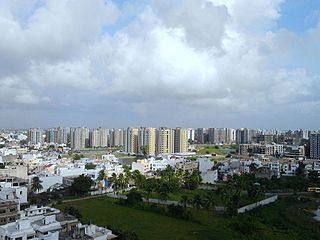
Surat is a city in the western Indian state of Gujarat. The word Surat literally means face in Gujarati and Hindi. Located on the banks of the river Tapti near its confluence with the Arabian Sea, it used to be a large seaport. It is now the commercial and economic center in South Gujarat, and one of the largest urban areas of western India. It has well-established diamond and textile industry, and is a major supply centre for apparels and accessories. About 90% of the world's diamonds supply are cut and polished in the city. It is the second largest city in Gujarat after Ahmedabad and the eighth largest city by population and ninth largest urban agglomeration in India. It is the administrative capital of the Surat district. In recent years, Surat has been in news for making a Guinness World Record for the largest gathering for a yoga session at one place where 1.53 lakh people joined the event on International Yoga Day.
The fast food industry in India has evolved with the changing lifestyles of the young Indian population. The variety of gastronomic preferences across the regions, hereditary or acquired, has brought about different modules across the country.
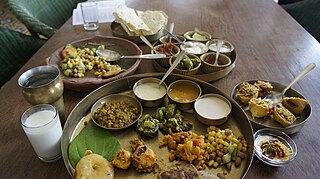
Gujarati cuisine is the cuisine of the Indian state of Gujarat. The typical Gujarati thali consists of rotli, dal or curry, rice, and shaak. The thali will also include preparations made from pulses or whole beans such as moong, black eyed beans etc., a snack item (farsaan) like dhokla, pathra, samosa, fafda, etc. and a sweet (mishthaan) like mohanthal, jalebi, doodh pak etc.

Undhiyu is a Gujarati mixed vegetable dish that is a regional specialty of Surat, Gujarat, India. The name of this dish comes from the Gujarati word "undhu", which translates to upside down, since the dish is traditionally cooked upside down underground in earthen pots, termed "matlu", which are fired from above.

Kadhi, or karhi, is a popular dish mainly consumed in South Asia. It consists of a thick gravy or soup based on gram flour, and it may contain vegetable fritters called pakora, which include dahi (yogurt) for a sour taste. It is often eaten with cooked rice or roti. Varieties of kadhi include those from Rajasthan, Maharashtra, Gujarat, Punjab, and Sindh, all of which are located in present-day India and Pakistan.

Shankarpali, shakkarpara, murali, khurma, lakdi mithai, or just simply mithai is an Indian sweet snack. It is etymologically derived from Persian Shekarpareh. Shankarpali is popular in India, especially in north India, specifically Uttar Pradesh. Its North Indian variant known as khurma or laktho is also popular in states such as Bihar, Jharkhand, and eastern Uttar Pradesh. It is also a popular sweet among the Indian diaspora in Fiji, Guyana, Mauritius, Suriname, and Trinidad and Tobago, as well as their respective diasporas in North America, the United Kingdom, Australia and New Zealand. It is traditionally enjoyed as a treat on Diwali. It is rich in carbohydrates, making it an instant source of energy. It can be sweet, sour or spicy depending upon how it is made.

Dhansak is a popular Indian dish, originating among the Parsi community. It combines elements of Persian and Gujarati cuisine. Dhansak is made by cooking mutton or goat meat with a mixture of lentils and vegetables. This is served with caramelised white rice, whole spices, and caramelized onions.

Ghari or Surati Ghari is a sweet Gujarati dish from Surat, Gujarat, India. Ghari is made of puri batter, milk 'mawa', ghee and sugar - made into round shapes with sweet filling, to be consumed on Chandani Padva festival. It is also available in many varieties and flavours such as pistachio, almond-elachi and mawa.
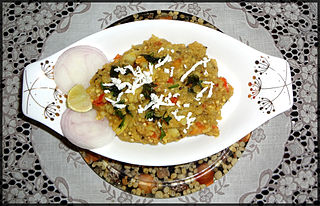
Baingan bharta or Baigan Chokha is an Indian dish prepared by mincing grilled eggplant (baingan) and mixing it with tomato, onion, herbs and spices. Grilling the eggplant over charcoal or direct fire infuses the dish with a smoky flavour. Mashed eggplant is then mixed with cooked chopped tomato, browned onion, ginger, garlic, cumin, fresh cilantro, chili pepper, and mustard oil or a neutral vegetable oil. Traditionally, the dish is often eaten with flatbread and is also served with rice or raita, a yogurt salad. In Bihar and Uttar Pradesh, it is served hot with litti or baati.

Farsan or Pharsāṇ refers to salty snacks originating from the Indian subcontinent. Farsans are a very important part of Marwari cuisine, Gujarati cuisine, Marathi cuisine and Sindhi cuisine, wherein a wide variety of them are prepared on special occasions and to entertain guests, and are also enjoyed with tea. Farsan is also found throughout the rest of India, particularly Maharashtra due to the influx of Gujarati and Rajasthani traders and migration of Sindhis in Mumbai.
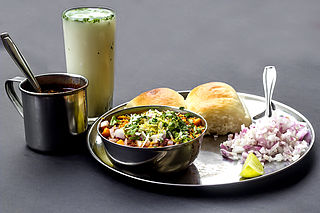
Misal pav is a dish from the Indian state of Maharashtra. It consists of misal and pav. The final dish is topped with farsan or sev, onions, lemon and coriander (cilantro). It is usually served hot with bread or rolls toasted with butter and buttermilk or dahi and papad. It is served as a breakfast dish, as a snack and also as a full meal.

Khichra or Khichda is a variation of the dish Haleem, popular with Muslims of the Indian subcontinent. Khichra is cooked all year and particularly at the Ashura of Muharram. It is made using goat meat, beef, lentils and spices, slowly cooked to a thick paste. It is the meat-based variant of Khichdi, a rice dish from the Indian subcontinent. In Pakistan, beef Haleem and Khichra is sold as street food in most cities throughout the year.

Dabeli, kutchi dabeli or double roti is a popular snack food of India, originating in the Gujarat. It is a sweet snack made by mixing boiled potatoes with a special dabeli masala, putting the mixture in a ladi pav, and serving it with chutneys made from tamarind, date, garlic, red chilies and other ingredients. It is garnished with pomegranate and roasted peanuts.

Khaman is a savoury snack from India that originates from Bombay in then British Bombay Presidency by a Marathi chef Bhoir for a Surat based Jain family sweets vendor that later found fame in Gujarat. It is a steamed savory sponge cake with a fluffy consistency, often served with a garnish of fresh chopped coriander leaves. The chef later stated that it was first created by his forefathers for Chimaji Appa and served along side Missal as a saffron bread to celebrate victory over Portuguese in Battle of Bassin. The name originates combining Kha meaning eat in Konkani and Kaman Fort where it was first served by then prominent Patil of Aagri people in Vasai creek region. When the British took over Bombay the then Patil's were hunted by Christian mobs and therefore they took his mothers family name that was Bhoir. They survivors left Vasai and moved to other side of the creek where there was strength in numbers. The Mumbai islands saw rapid demographic & geographic change impacting Aagri people negatively. The state policy to crush backers of Azad Hind leading to Navel Mutiny targeted native tribes of the islands for aiding Bose against system. Chef Bhoir's generations were traced working in low jobs residing in Rai-Murdha villages by a branch sweet vendors family that moved in 90's to United Kingdom. The story was picked by multiple Indian historians and is gaining traction. Today the snack has become household name across the world.

Sev is a popular Indian snack food consisting of small pieces of crunchy noodles made from chickpea flour paste, which are seasoned with turmeric, cayenne, and ajwain before being deep-fried in oil. These noodles vary in thickness. Ready-to-eat varieties of sev, including flavoured sev, are available in Indian stores.

Gram flour or besan is a pulse flour made from chana daal or brown/kaala chana, a chickpea. It is a staple ingredient in the cuisine of the Indian subcontinent, including in Indian, Bangladeshi, Burmese, Nepali, Pakistani, Sri Lankan and Caribbean cuisines.

Papad ki Bhaaji or Papad ka Saag is a vegetarian main course dish made using Papad and is popular in Rajasthani, Gujarati, Bundeli, Malwi, Nimadi and Braj cuisines. The dish is prepared with many variations and is also known by the name Papad ro saag in Rajasthani and Papad nu shaak in Gujarati. Papad ki bhaaji can be easily prepared with few basic ingredients at home and without the need of any vegetable. Hence it typifies the simple food that one needs for sustenance amidst the hardship of desert life.
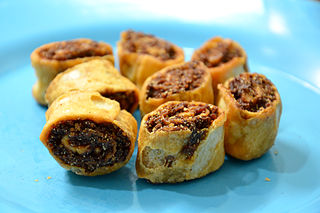
Bakarwadi in Marathi Maharashtrian traditional crispy, deep-fried, disc-shaped, sweet and spicy snack popular in western state Maharashtra in India. It was already popular before 1960 when these were not Gujarat nor Maharashtra state; they were both Bombay State and both cultures added their own flavors in each other's recipes.

Umbadiyu or Ubadyu is local delicacy and seasonal dish from districts of South Gujarat, Navsari, Surat and Valsad. However mostly the dish is made in rural areas of Valsad or near National Highway 48 from Dungri to Umargam. And also found in UT of Dadra and Nagar Haveli and Daman and Diu.



















